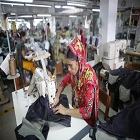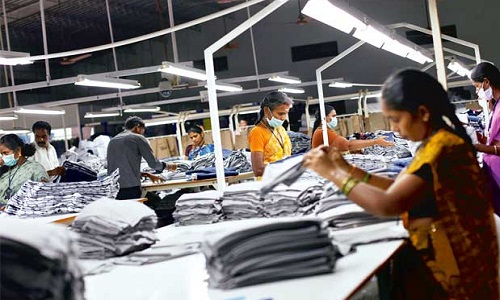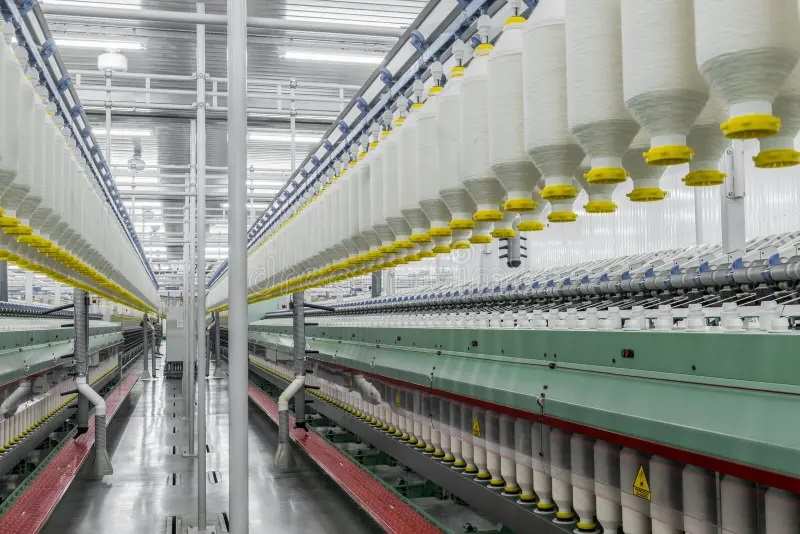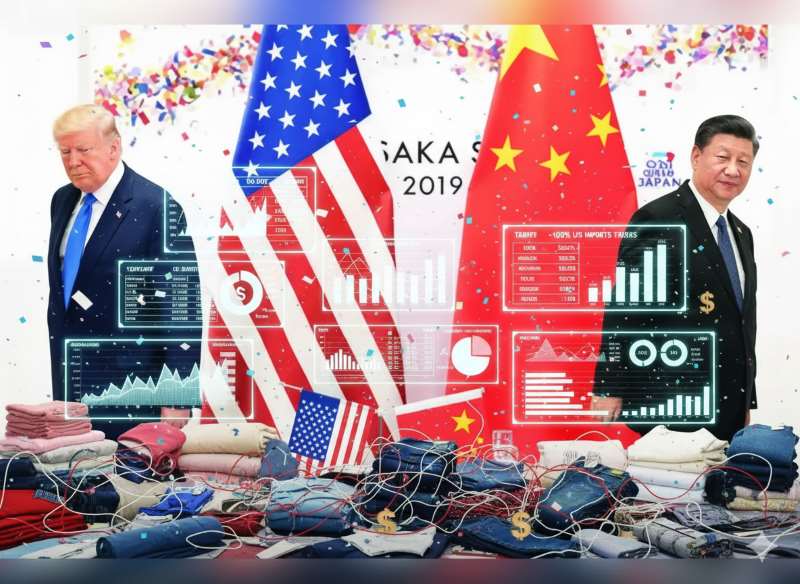FW
The third anniversary of Rana Plaza, the deadliest tragedy in Bangladeshs’ garment industry, which claimed the lives of more than a thousand workers in is round the corner. The attention now turns to the millions of garment workers, surviving on poverty wages, who make the clothes we wear. What can we do to help these workers, out of which 80 per cent of whom are women. Certainly not to only buy vintage or second hand - as two fashionistas recently proposed on a BBC program. Garment workers desperately need to keep their jobs, so boycotting brands is not the way forward. They want to work. In many countries the garment industry is one of the few avenues to financial independence for women.
According to United Nations Guiding Principles, multinational companies are responsible for the working conditions at their suppliers. Yet many fashion brands have little control or little idea of how much workers are being paid, how long they are working or how safe the factories are, and insufficient will to do anything about it. Brands’ short lead times, last minute changes to production specifications, and a general lack of consideration of how their demands impact on workers, put an impossible burden on the women making our clothes. Any change in the global garment industry has to be systemic and enforceable. Acting alone will not bring about the necessary changes needed to improve the lives of garment workers.
There needs to be a critical mass of brands to wake up and realise that their supply chain operations are abusive and unsustainable.
According to Union Minister Santosh Kumar Gangwar, India's textile export remained flat at $40 billion in the last fiscal, as compared to $41.4 billion in 2014-15. However, an export during last fiscal was lower than the target $47.5 billion set by the government for textile and clothing. The subdued trend in export was due to recessionary trend in Europe and the US markets, experts say. About the technical textile sector, the minister said the country sees a huge growth potential in the sector. Gangwar pointed out that the growth rate of technical textile sector is expected to be much higher.
Based on past trends of growth and estimated end user segment growth, the Working Group on Technical Textiles for 12th Five Year Plan (FYP) has projected the market size to Rs 1.58 lakh crore for the year 2016-17 with a growth rate of 20 per cent. According to the minister, Technotex exemplifies the immense potential for trade and investment between India and foreign countries in technical textile sector.
IGATEX is being held in Pakistan from April 20 to 23, 2016. This is a garment, textile, leather machinery and accessories exhibition. It showcases products from apparel and clothing, plant, machinery and equipment, textile, fabrics and yarns, business services, knitting and stitching industries.
The event introduces the newest expertise, improves trade benefits and increases foreign investment through business visits by international delegates. The event will provide business opportunities and add value to exports that would positively impact the economy of the country. IGATEX is a benchmark event in the entire textile and garment machinery industry with a massive influx of industry professionals, manufacturers, researchers, traders and decision makers of business entities.
The ongoing exhibition is seeing many foreign participants from 35 countries, 550 companies, 52,000 visitors with extraordinary trading and business engagements across the industry. Pakistan has become a focal point for investors in the region and has gained recognition as an important market for textile manufacturers. IGATEX 2016 will enhance the exposure and reach of textile exhibitors and provide them the right platform to display their accessories in order to gain potential business opportunities.
Since its inception in 2002, the event has played a pivotal role in the development of the textile industry by introducing efficient machinery to local manufacturers.
igatex.pk/
Mauritius has invited Pakistani textile exporters to explore business opportunities in addition to arranging a fashion show of Pakistani brands in the country. Mauritius President Ameenah Firdaus Guarib-Fakin extended the invitation during a meeting with the All Pakistan Textile Mills Association (APTMA) recently.
Fakin said there were huge opportunities on the technical side of the textile sector in Mauritius – a small island nation located on the east of mainland Africa and often termed ‘the gateway to Africa’ – that remained unexplored. Moreover, the President said, Pakistani entrepreneurs could also take advantage of Mauritius to penetrate the United States (US) and European markets. According to APTMA Chairman Tariq Saud, there was a need of close liaison between the business communities of the two countries and invited Mauritian entrepreneurs to enter into joint ventures with Pakistani textile mills.
Bank of China's Ho Chi Minh City Branch signed a $103 million syndicated loan for a Vietnam-based subsidiary of leading Chinese yarn manufacturer Texhong Textile Group, partly helping foster the good investment and trade relations between the two countries.
Provided by eight foreign and Vietnamese banks, the loan, including Bank of China's Ho Chi Minh City Branch, will be used to broaden and deepen production of Texhong Galaxy Technology Company which was established in the northern province of Quang Ninh with investment capital of $300 million. Now, Texhong Textile Group, a leading cotton textile manufacturer in the world, has four production bases in Vietnam.
Director of Bank of China's Ho Chi Minh City Branch Wang Hao thanked the Chinese firms' expanded investment in Vietnam and relevant stakeholders' involvement, the bank has had opportunities to enhance its financial services' performance in the country, contributing to the fine economic ties between China and Vietnam.
According to the Director of Bank of China's Ho Chi Minh City Branch, the two-way trade between China and Vietnam will surpass $100 billion this year, and Vietnam will overtake Malaysia to become China's biggest trading partner in Southeast Asia.
"Bangladesh has emerged an attractive destination for Indian RMG manufacturers. Many have set up units in the country simply because Bangladesh offers ease of doing business, importing-exporting is faster. R&D on new styles is faster as you can import fabrics in three days where as in India, it would take 10 days. In fact, the list of Indian companies setting up garment units in Bangladesh is long."

Bangladesh has emerged an attractive destination for Indian RMG manufacturers. Many have set up units in the country simply because Bangladesh offers ease of doing business, importing-exporting is faster. R&D on new styles is faster as you can import fabrics in three days where as in India, it would take 10 days. In fact, the list of Indian companies setting up garment units in Bangladesh is long.
Indian RMG exporters set up units in Bangladesh
Gurgaon-based and BSE-listed Pearl Global Industries set up a garment manufacturing unit in Bangladesh 12 years back. The company, which has 4,000 machines across four factories in the neighbouring country, is planning to double its capacity in the next three years. Chennai-based Ambattur Clothing has two units in Bangladesh which employ 8,000 people. It supplies clothes to brands such as Zara, Gap and Taylor. While the units in Bangladesh account for 60 per cent of the company's business, Chennai accounts for only 15 per cent.

So far, Orient Craft, a Delhi-based garment exporter which employs 32,000 people, stayed away from Bangladesh. Now, even Orient Craft is thinking of setting up a unit in Bangladesh. Say Indian exporters, as India's garment exports stagnate at $17 billion a year, Bangladesh's apparel exports are growing at double digits and are likely to touch $27 billion this year. India's garment exports were $15.49 billion between April and February 2015-16, up only 1.5 per cent over the corresponding period last year.
Bangladesh clocked $18.12 billion in apparel exports between July 2015 and February 2016, growing by 9.52 per cent over the corresponding period last year. For the past four months, its exports have been between $2.2 billion and $2.6 billion per month. The country overtook India in 2008 and its share of world trade began to climb from 2010 (4.19 per cent vs India's 3.16 per cent). Interestingly, India's share of the world trade in garments increased from 3 per cent in 2000 to 3.78 per cent in 2010. In 2014, India's share was 3.67 per cent while Bangladesh's share was 5.09 per cent, according to WTO data on clothing exports as of October 2015.
According to Sudhir Dhingra, Founder & Chairman, Orient Craft, the Indian government is not willing to do much (like bilateral trade deals with EU and others to drive competitiveness). “If we can't beat them, join them.” Vijay Mathur, Additional Secretary General, Apparel Export Promotion Council, points out exporters are shifting to Bangladesh as buyers want it that way. Bangladesh offers ease of doing business, importing-exporting is faster. R&D on new styles is faster as you can import fabrics in three days. In India, it would take 10 days. The more samples and styles you produce, the better the chances you stand to get an order. More than Indian exporters, it is Indian business families based in Sri Lanka and Hong Kong who have made the most of Bangladesh. These include Hong Kong-based groups like Must Garments, Epic Garments and Sri Lanka-based groups like Brandix, MAS Holdings and Hydramani Groups.
Advantage for Bangladesh exports
Bangladesh’s biggest advantage is duty-free exports to markets like the European Union, Japan, Australia and Canada under a preferential tariff system called Generalised System of Preferences (GSP), which provides an exemption from the more general rules of the WTO. Garment exports from India to Europe attract an import duty of 11-12 per cent.
Moreover, labour cost in Bangladesh is 25 per cent lower than India. A skilled worker in India, with two-hours of overtime, costs $200-$225 a month, while a similar worker in Bangladesh is available for $140-150 a month. Bangladesh’s labour is not just cheap, but also highly skilled - garment exports account for 82 per cent of Bangladesh's total exports.
In the past, power cost was 50 per cent lower than India due to abundance of gas, but that difference has come down. There's still some difference as boilers, generators and vehicles run on gas. Oil has come down to $40/barrel, but in India government is still increasing fuel prices, says an Indian exporter.
It's all about focus. In India, when you have consecutive holidays, like this week, the customs is closed. In Bangladesh, it is open 24x7 throughout the year. Even if you have strikes, vehicles ferrying garments enjoy exemptions, according to Dhingra. Also, provident fund or medical cover for workers is not statutory in Bangladesh. Working conditions are also poorer than India. A recent study by US brands found that only 24 of the 700 factories inspected met international safety standards.
Loss of opportunity for India
Owing to the duty disadvantage and higher costs, India became uncompetitive. It has vacated the mass-market for garments (shirts, trousers) and now largely plays in the fashion segment for value-added garments, like embroidery or in garments which need a lot of handwork, or premium garments that cost upwards of $15. Growth in garment industry can add a lot of jobs but exporters feel the government is oblivious to the opportunity.
One way to drive competitiveness is to go for bilateral agreements with key countries, seeking duty-free exports.
According to Dhingra, a bilateral agreement with European Union, which links foreign investment from EU to duty-free exports of garments from India, can grow exports to Europe 3-4 times to $24 billion-$26 billion in three years, from $9 billion today.
Pakistan’s textile export declined 8.16 per cent during the first nine months of the current fiscal year. Raw cotton exports recorded a decline of 47 per cent during the current fiscal year while cotton yarn fell by 32 per cent.
Export of raw cotton cloth declined by 10.14 per cent during the first nine months of the current fiscal year. Export of cotton carded or combed declined by 97 per cent during the first nine months. Knitwear exports declined by 2.10 per cent and bed wear exports fell by 4.13 per cent. Tents, canvas and tarpaulin exports decreased by 27 per cent in July to March 2015-16 as compared to July to March 2014-15. Art, silk and synthetic textile exports declined by 13.11 per cent during July to March 2015-16 against July to March 2014-15.
Made-up article exports registered a decline of 3.46 per cent during the current fiscal year. Exports of raw cotton declined by 66.68 per cent in March 2016 compared to the same month of the last fiscal year. Cotton yarn exports in March 2016 fell by 29.16 percent compared to March 2015. Cotton cloth exports fell by 5.52 per cent, cotton carded or combed export by 61.54 per cent, and exports of yarn other than cotton yarn by 8.66 per cent. Exports of towels fell by 6.51 per cent, art, silk and synthetic textile exports by 17.74 per cent, made-up articles by 1.11 per cent.
The Indian textile industry has been facing a long-drawn recession since April 2014. To enhance the industry’s competitiveness, the two per cent MEIS (Merchandise Exports from India Scheme) benefit has been extended for all textile products other than cotton yarn.
The TUF scheme has been extended for the entire 13th five-year plan period. A sum of Rs 17,822 crores has been allotted to meet the committed liabilities of the schemes in the pipeline as also the ongoing and new schemes.
Under the amended TUF scheme, the spinning sector has been excluded while a 15 per cent capital subsidy has been extended for garments and technical textiles and a 10 per cent subsidy for weaving and processing sectors. Interest subsidies ranging from two per cent to six per cent extended under the earlier scheme have been discontinued.
As TUF subsidy refunds have been pending for more than one and a half years, the working capital has been totally eroded and most spinning mills are incurring cash losses due to the glut in the market. The industry has been hit by the global economic slowdown. Major markets have imposed a higher tariff on Indian textile and clothing products than they have on imports from competing nations like Pakistan, Bangladesh, Vietnam, Turkey and Cambodia.
Primark the European fast fashion retailer that offers men’s, women’s, kids’, home, beauty, active wear has seen a rise in revenues. Primark’s adjusted operating profit fell one per cent in constant currencies for the 24 weeks to February 27compared with the previous year, and three percent at actual currency rates, as the dollar strengthened against the euro. Sales were up seven per cent in constant currency on 2015, driven by increased retail selling space. Revenues rose five per cent but operating profit was down three per cent.
Primark had a few tens of millions fewer units of products across the entire group, compared to the same period last year. Its responsive supply chain is key to riding out unpredictable weather patterns and shifts in customer behavior. The chain has managed well with the inventory it had in January and February. It has kept a close eye on how sales were developing last autumn and reduced its buying volumes which ultimately led to less markdown in January and February. That has shown in its bottom line.
Primark's sales were hit by warm weather over the Christmas period. Profits at the chain were affected by currency movements. However the brand plans to open six more stores in the US this year.
Ethical Movement Fashion Revolution published its inaugural Fashion Transparency Index as part of the launch of the Fashion Revolution Week recently. Developed in conjunction with Ethical Consumer, the research includes 40 of the biggest fashion brands and ranks them according to the level of transparency in their supply chain.
Levi Strauss & Co, with brands Levi’s, Dockers, Signature and Denizen was ranked the most transparent fashion company with a 77 per cent score. It was followed by Inditex (76 per cent), H&M (76 per cent), Adidas (69 per cent) and Primark (67 p0er cent), while the worse rated brands included Chanel (10 per cent), Hermes (17 per cent), Claire’s Accessories (17 per cent) Forever21 (19 per cent), Fendi (19 per cent) and LVMH (19 per cent).
The research also revealed that 40 per cent of companies do not have a system in place to monitor compliance with labour standards and that only 11 companies show evidence of working with trade unions, civil society or NGOs on the ground in supplier countries to improve working conditions.












